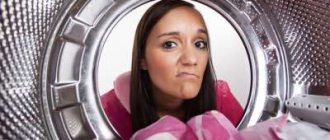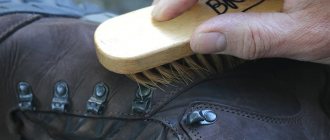The washing machine has been indispensable in the home for more than a century. They learned to make it smart and reliable and easy to use. But sometimes owners are upset by the appearance of an unpleasant odor in the washing machine. The main trouble is that the musty smell transfers to the washed items.
Otherwise, the machine continues to work well, so there is no reason to change it. All you need to do is find out how to get rid of the smell in your washing machine at home. Let's find out what reasons can cause it and how to deal with it.
If there is a smell in the washing machine, then it is important to find the reason for how to get rid of it. An unpleasant odor in the washing machine can occur due to various reasons.
Causes of bad smell in the washing machine
Therefore, you should avoid making such mistakes when using the machine at home:
- You should never store soiled laundry items in the drum. This makes it difficult to dry the tank and leads to the development of colonies of bacteria or even mold, which causes a musty smell in things and in the machine.
- Always check the pockets and cuffs of items before washing to prevent stray debris from clogging the machine. Once accumulated in the filter, it can become rotten and cause an odor.
- Although most things can be washed using more gentle and economical washing modes, where the temperature does not exceed 60C. It is necessary to periodically use intensive washing mode, with water at a temperature of 90C or higher. This not only removes heavy dirt, but also disinfects the machine itself.
But it’s not only our mistakes in using the machine that can cause unwanted odors. Poor-quality detergents, clogged drains, stagnant moisture - all this can cause rotten odors.
Excessive use of conditioners and rinses can also lead to an unpleasant odor. These products are usually quite thick in consistency, may not dissolve immediately, settle on the walls and in the tray and, when decomposed, become a source of odors.
Then it is the compartments for powder and rinse aid that become the main problem area.
First of all, to eliminate the smell, you will need to clean them.
Low-quality detergents also dissolve poorly; particles remain in the machine parts. The result is known! How to get rid of the smell in the washing machine in this case. First of all, we need to return to already proven powders that have proven themselves well.
The quality of the water also leads to precipitation, especially on the heating element. If it is hard, then quite quickly a coating appears on it, which over time begins to peel off and settles at the bottom of the device. Colonies of bacteria, etc. appear in this layer.
The source of unpleasant odors can be an old drain hose, in which microcracks appear over time. They accumulate all kinds of sediment and microorganisms.
How to remove the smell from the washing machine in this case? Separate the hose and rinse it thoroughly with running water. If a more thorough cleaning is required, first soak it for several hours in a solution with a cleaning agent. After getting rid of accumulated dirt, rinse thoroughly. If this does not help, then you will have to change it.
Rules for using the machine to prevent mold from appearing
Washing machine professionals and manufacturers recommend taking preventive measures:
- Wash clothes once a month at 95 degrees. If there is no such clothing, run the program empty.
- Do not get carried away with helium products. Alternate them with regular powders.
- Do not close the hatch after washing. Wipe the drum and seal with a sponge or dry cloth.
- Check the powder container and rinse aid. You can use a product with chlorine or vinegar, they will help get rid of the problem at the initial stage.
- The washing dispenser can be cleaned with a brush and soda if it is not removable.
- Clean your machine regularly with professional descaling products.
- Do not accumulate dirty laundry in the drum; immediately remove wet, clean laundry.
- Inspect the filters and hose and clean them promptly.
In order for devices to work for a long time and not require regular repairs or replacement of parts, you need to monitor their life. Carry out an inspection, get rid of scale and mold, visible and hidden dirt.
As the fungus grows, it covers the parts of the washing machine with a black layer, leaves marks on washed clothes, and spreads an unpleasant odor throughout the room. The machine can be anything (top-loading, usual), but it is more difficult to get rid of mold; it is better to carry out prevention. Under this condition, mustiness will not appear, and you will not have to think about how to get rid of the fungus.
The article has been verified by the editors
Bacteria and mold on the rubber seal and in the drum
Sometimes a musty smell appears because the machine is not level. Then all the water does not leave the machine and stagnates inside, becoming a breeding ground for mold or bacteria. Most often the tank suffers from this.
High humidity remains in it even if you simply do not dry it, and if the machine is crooked, then moisture stagnation is guaranteed.
Then a smell may appear from the drum. It may also contain sediment for some reason.
Sometimes the machine smells bad due to the condition of the hatch cuff. Liquid also often stagnates in its folds, various little things and undissolved particles of used products settle. To remove odors, you need to thoroughly rinse these parts in the machine.
Faulty sewerage - source of odor
Sometimes the machine smells like a sewer. Sometimes this is caused by actual problems in the sewer system, and sometimes it can occur due to errors in the connection or operation of the machine.
When the smell of sewage appears in your machine immediately after installation, the cause may be improper operation of the drain hose. Here you should carefully study the instructions again and, following them exactly, reinstall the hose.
If the cause of the stench is problems with the sewerage system, then the smell will be felt not only in the machine and the clothes washed in it, but also from the sink. This means that there is a blockage in the sewer pipes and it is necessary to clean them.
An unpleasant smell from the washing machine may be due to a clogged drain filter.
Traditional methods for removing odors from automatic machines
Many manufacturers of household appliances and chemicals are thinking about how to get rid of the smell from an automatic washing machine. Therefore, you can find a variety of products in stores. But there are also folk remedies that can help.
Before talking about the means themselves, let’s present an algorithm of actions:
- First, use a sponge or rag to remove plaque and debris in places that can be reached without problems.
- Then, with the selected product, we start the wash empty, without items.
- Then we start the rinse mode.
This also helps to clean the internal parts of the machine that cannot be reached otherwise.
Vinegar
Many people, thinking about how to eliminate the smell in an automatic washing machine, choose such an affordable product as vinegar.
It is well suited for removing scale and limescale and has a good disinfecting effect.
For this purpose, pour two glasses of vinegar into the compartment or directly into the tank and turn on the wash at high temperature. Then, after five minutes, work is stopped for an hour so that the product has time to thoroughly soften the plaque. Then they start the wash again. After its completion, manually clean the filter and heating element from the exfoliated build-up.
After cleaning everything, use a cloth soaked in vinegar diluted with water (1:1) to thoroughly wipe the inner surface of the tank, the cuff and the hatch. After which everything is thoroughly wiped dry. You should not do this type of washing with vinegar too often. This can cause rapid wear of individual parts.
Citric acid
Washing with citric acid has a largely similar effect on scale, plaque and various microorganisms. The acid eats away accumulated sediment and kills mold. You can't use lemon juice here. A higher concentration of acid is needed, which can only be provided by citric acid crystals.
Top 5 chemicals for cleaning rubber parts
If folk remedies don’t help, it’s time to turn to special household preparations. Top 5 products will remove mold or mildew quickly, permanently and inexpensively.
HG
A universal product that removes mold, various types of harmful microorganisms, and unpleasant odors. HG is more often used for cleaning tiles, but it is suitable for rubber and silicone products.
Mode of application:
- apply to mold or mildew,
- wait 1-2 hours,
- wash off with a damp sponge.
Price: from 400 rubles.
Tiret
The combination of affordable price and effectiveness makes Tiret a very popular means for cleaning a washing machine from mold or mildew. The cost of 250 ml is only 200 rubles.
Mode of application:
- moisten the sponge in Tiret and wipe the infected area several times,
- leave for 30-40 minutes,
- rinse with clean water.
Blanidas
Blanidas belongs to the category of professional chemistry. Like HG, it is most often used to clean tiles and tiles, but can also be applied to rubber seals. Price: 400 rubles.
Mode of application:
- soak a sponge in Blanidas and wipe the infected area several times,
- leave for 1-1.5 hours,
- rinse with clean water.
Dr. Beckmann
Good quality product at an affordable price. Cost of Dr. Beckmann is only 300 rubles.
Mode of application:
- fill up the contents of one Dr. package. Beckmann directly into the washing machine drum,
- turn on the “Rinse” mode,
- After finishing work, wipe the inner surface of the drum thoroughly and dry.
Sama
A cheap but high-quality product for removing mold and mildew. In addition to cleansing, it also has a disinfecting effect. Price: 100 rubles.
Mode of application:
- apply to the contaminated surface,
- after 30 minutes, rinse with clean water.
How to clean the cuff and drum
What to do, how to remove the smell in an automatic washing machine if its source is the cuff and drum? These car parts are not difficult to obtain.
First, carefully push back the folds of the cuff and carefully remove any debris that has accumulated there with a cloth.
Then we soak a rag in some kind of disinfectant such as bleach or vinegar, and thoroughly wipe the cuff. We do the same with the tank. We wipe its walls with a product that contains chlorine to kill fungi and microorganisms. You can also use other means for this.
How to replace the rubber hatch cover
If mold remains in the washing machine after cleaning the cuff, then you will have to replace it. In order for such a replacement to be successful, you must first of all buy not just a similar one, but one specifically designed for your model, and only after making sure of their identity proceed with the replacement.
The method of attaching the cuff to the machine varies from model to model, and the method of detachment will also vary.
One will be for plastic clamps, the other for metal ones, secured with latches, springs or screws. Therefore, read the instructions carefully.
When to contact a specialist
When independent methods do not work, folk or professional remedies do not help, the smell remains, it is impossible to determine its origin, it is recommended to contact a specialist, he will help get rid of the mold.
A professional will disassemble the automatic washing machine, carefully check the parts, advise which ones are best to replace, and what to pay attention to.
You can find out from a repairman which of the existing methods actually work and which ones spoil and wear out the parts of the washing machine. It is recommended to follow the advice of professionals so that the unit lasts a long time and does not require replacement or expensive maintenance.
How to remove dirt from the drain filter
During long-term use, fabric fibers, hair, wool, paper accidentally caught in pockets, etc. gradually accumulate in the filter. As it accumulates, it retains some of the moisture even after the washing process has stopped. Under the influence of heat and moisture, these cleaning products begin to decompose and bacteria grow in them.
As a result, we feel the rotten smell coming from the washing machine, like a clogged sewer. To eliminate the unpleasant smell from the washing machine, we first get rid of the accumulated garbage.
If you are confident enough in handling household appliances, you can do this yourself, using the instructions in the technical passport of your machine. Unscrew the plug with the filter and remove any debris that has accumulated there.
Then wash the filter with detergent and reassemble after that. Or you can entrust a specialist to clean the washing machine, eliminating this cause of the smell.
Household chemicals: review of products
The question of how to get rid of an unpleasant odor in a washing machine can be solved with the help of household chemicals specially designed for this. These products are designed to remove scale, mold and other causes of odor. They are available in tablet, powder and liquid form.
This is, for example, the widely advertised Calgon and its analogue from another manufacturer Alfagon. These and other similar tools are quite good and if your budget allows it, then it is better to use them. Water softeners, which come in the form of tablets and concentrates, also help to preserve your machine.
Cleaning products
Both traditional and special detergents from the hardware department of the store are used as a means to clean the washing machine from musty odors, mold and dirt. This process is easy and you can do it yourself. Let's look at popular cleansing products.
Copper sulfate
Copper sulfate can remove the mold itself for a long time, and also get rid of the mold smell in the washing machine. It consists of small blue particles. This powerful poison is used in agriculture when treating against bacteria, so gloves must be used for protection. To prepare the solution, mix copper sulfate, washing powder and water. Apply it to areas where mold accumulates and leave it there for several hours, then use a rinse cycle to remove any residue.
Hydrogen peroxide
A quick and easy way to remove mold is to replace chlorine bleach with 3% hydrogen peroxide. Both when used in medicine it is an antiseptic, and when used in equipment it combats several problems:
- Kills fungus.
- Removes limescale.
- Has an antibacterial effect.
- Destroys viruses.
Using hot water will help remove traces of mold more thoroughly. At the same time, it is safe and does not harm health.
Lemon acid
Citric acid is a commonly used remedy for getting rid of mold. For use, use a couple of packages of acid, which are sold in any market. Place it in the detergent compartment or in the drum, start the washing cycle at a temperature above 90 degrees, preferably with a soaking program. It is recommended to use this method every 4-5 months. Citric acid is great for removing musty smells from your car.
Bleaching
You can clean mold from your washing machine using chlorine bleach. Use it with warm or cold water, as it stops working in hot water. Limescale deposits do not disappear after bleaching and additional measures must be taken. Bleach may not get into the internal parts, so this method is good for light contamination. During cleansing, the product is left for several hours and an additional wash without powder is run at high temperature to remove residual chlorine-containing substances.
Soda
You can clean the washing machine from mold and get rid of the smell inside with soda. Soda is diluted with water to a paste and applied to areas where mold accumulates, leaving this mixture for half an hour. Next, rub the product over the surface with a sponge and start the rinsing mode. More effective cleaning will be when mixing the product with washing powder. Baking soda is good at getting rid of musty odors due to its ability to absorb bad odors.
Vinegar
Vinegar helps clean your washing machine, as does acetic acid. Only use a 9% solution of the product. It is recommended to use a synthetic substance. Apple cider vinegar or wine vinegar may contain oils that will only leave additional residue on the surface of the equipment. After cleaning, the unit must be wiped dry and ventilated well.
Chemicals
The following substances can be used:
- toilet fluid;
- washing powder;
- dishwashing liquid.
Toilet fluid perfectly kills fungus and various pathogens. Apply it to the inside of the machine, rubber surface, powder container. Leave for a few minutes and clean with a sponge. Wipe dry and run an express wash to remove excess substances.
External manifestations of black mold can be removed using the same washing powder and dishwashing detergent. This will not get rid of the fungus and it will begin to appear again. Therefore, other methods need to be used. The method of using cleansing is the same as for any cleaning. It is necessary to thoroughly wash all components of the equipment, then thoroughly rinse, wipe and ventilate the machine. The powder and dish soap are safe for skin and can be used without gloves.
Special products from hardware stores
Many people recommend cleaning your car with products from hardware stores. These products remove three problems at once: dirt, mold and scale.
They appear in the form of sprays, solutions or special powders. They are used both externally and added when washing to the detergent compartment. Cleaning in this way is very effective, but requires additional money. These products can be used for disinfection after washing very dirty items or for cleaning when washing children's clothes.
Prevention of foul odor
To avoid any reason to wonder how to get rid of the smell from a washing machine, it is better to take preventive measures in advance:
- Choose high-quality detergents, do not exceed the dose of powder recommended by the manufacturer, and dilute thick rinses with water before adding them so that they dissolve well and do not settle on the walls.
- At least 2 times a year, run a dry wash with cleaning agents at a temperature of at least 90C.
- After finishing washing, leave the drum open for a while for better drying.
- Finally, wipe off any remaining moisture in the cuff and check the drum for moisture. If the machine is even slightly uneven, some of the water may remain at the bottom.
- Check how level your washing machine is.
- Check items carefully before putting them in the wash to ensure that debris and small items do not accidentally get in.
If you follow these simple rules and avoid the mistakes that we have already talked about, then you will not be in danger of encountering the fact that the machine smells rotten, and black mold is visible on the walls of the unit. It is easier to do this and prevent it than to deal with the consequences of mistakes later.
- How to remove nail polish from clothes
- Liquid washing powder
How to prevent mold
Yes, you can if you follow simple rules:
- Regularly use the high temperature mode (95 ° C), even if you don’t need to wash anything, run the program idle for a maximum time 1-2 times a month.
- Do not use gel-based laundry detergents; very often the gel settles on the internal drains of the machine and creates a breeding ground for a colony of fungi. Use balms, conditioners, and softeners less often.
- Wipe all accessible parts of the machine with a dry cloth after washing, do not close the lid - let all the moisture evaporate.
- After each wash, remove the powder container, rinse with running water, you can additionally wash with bleach, and dry separately. If the dispenser is not removable, do not push it in and clean it from time to time with soda and an old toothbrush.
- Get rid of scale in a timely manner; the fungus feels quite comfortable in its porous structure. Table vinegar is suitable for removing scale; it is also useful for cleaning the shower stall from limescale.
- Remove the laundry from the machine as soon as the wash is finished.
- From time to time, thoroughly clean the hoses and filters from accumulated dirt; organic residues in the filters serve as a source of infection.











